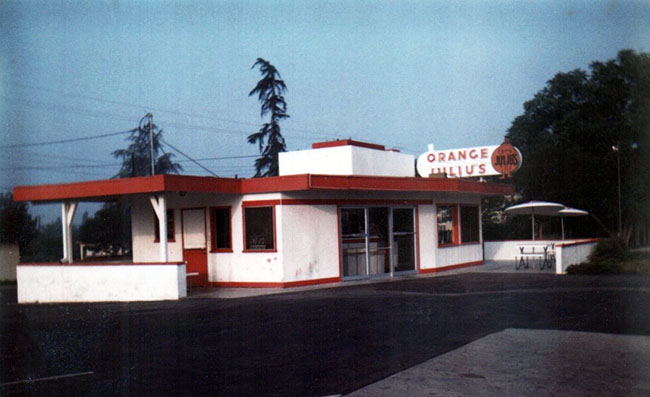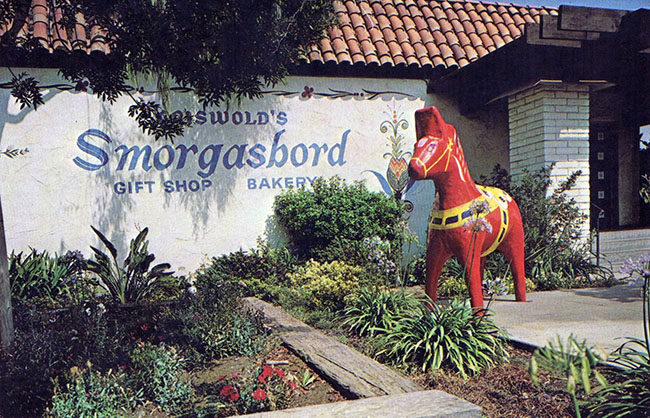Route 66 nears 100: share your story

Orange Julius, located on the south side of Foothill Boulevard just west of Indian Hill, was a favorite of locals and travelers alike. Photo/courtesy of Claremont Heritage
by John Neiuber
In 1990, my wife Karen and I packed up our sports car and embarked on a road trip on historic Route 66. It was a memorable adventure of map reading and detours to find the original route that had been bypassed by a series of interstate highways. The trip was highlighted by discovery and stops at the numerous roadside attractions, cafes, restaurants, and themed motels that had become the stuff of legend along “the mother road.”
This was, of course, prior to cell phone cameras and GPS, so it was all recorded on film and illustrated nicely by that once oft-used descriptor, “a Kodak moment.” Those moments became a favorite photo album, my favorite being of Karen (but not hers) perched on the saddle of the giant rabbit at the Jack Rabbit Trading Post in Joseph City, Arizona.
In 2026, Route 66 will turn 100. The National Trust for Historic Preservation has developed an initiative, Preserve Route 66. The National Trust is inviting anyone — community members, travelers, historians, or enthusiasts — to share their stories and photos about Route 66. They are asking for submissions about roadside attractions, treasured businesses, pieces of family history, or a personal memories. The contributions will become part of the archive of the history of Route 66, and will tell a more complete story of the iconic highway.
To participate, visit the National Trust website at savingplaces.org/your-route66-story, and click on “Share Your Story” to contribute. If you decide to participate, please email your description and photo to Claremont Heritage as well at archivist@claremontheritage.org.
Route 66 through Claremont is just a little over two miles long and can be traversed in about four minutes by car. Regardless, like many cities along the 2,400-mile route, Claremont citizens are proud to lay claim to Route 66. Many of us have our stories about Route 66, and our personal memories along the road, and Claremont has its fair share of favorite places in that two plus mile stretch.

Griswold’s Smorgasbord was a favorite stop for travelers traversing Route 66. Photo/courtesy of Claremont Heritage
Claremont Heritage urges the community to share stories about Route 66 through Claremont. I am sure readers have their favorites that once lined, and, in some cases, still line the road. One of the places I have always found fascinating is the Millard Sheets Studio, now home to an ophthalmology clinic, Claremont Eye Associates, at 655 E. Foothill Blvd. Sheets’ mosaic murals can also be found at Pomona First Federal, now U.S. Bank, at Foothill and Indian Hill boulevards, which is also an excellent example of new formalism architecture.
The Old School House, formerly Claremont High School, has been a fixture on Route 66 since before its designation as a national highway. Right across the street was Orange Julius, a favorite for locals and travelers alike. Hopefully it’s not just an inflated memory as a result of time, but I recall they had the best chili dogs! And just down the road was the Betsy Ross Ice Cream Parlor, now home to Claremont Optometry. With its patriotic, red, white, and blue motif, Betsy Ross was a must visit destination.
Travelers and locals frequented Wolfe’s Market. Founded in 1917, Wolfe’s has been known for quality and customer service for over 100 years. Griswold’s Stone Cellar, at 222 W. Foothill Blvd., was once the center of an extensive dried fruit and marmalade business run by a retired professor, George Griswold, and was a regular stop for travelers. The business later moved west and across Foothill Boulevard, and expanded to include Griswold’s Inn and Smorgasbord.
Any discussion of Route 66 through Claremont must include Tugboat Annie’s. Architecture that mimics an object is known as novelty architecture and can range from a sculptural building like the Statue of Liberty to a roadside attraction like the Cabazon dinosaurs. Probably the most often visited novelty architecture along Route 66 in California is the Wigwam Hotel in San Bernardino, one of only two remaining of the original seven, the other being in Arizona.
Route 66 was called “the mother road” by John Steinbeck in his novel, “Grapes of Wrath.” The road was traveled by those displaced during the Depression, so it came to symbolize loss, escape, and a promise for a better future.
For those along its route, the mother road took on a different meaning as it became known as the Main Street of America. Local entrepreneurs in every state opened businesses along its route and with it came prosperity until the interstate highway system bypassed the famous road. Change is one thing we can count on in life, and Route 66 has definitely changed. However, it can still be traveled, and you can still “get your kicks on Route 66.”
For more information visit the California Historic Route 66 Association at route66ca.org.










0 Comments